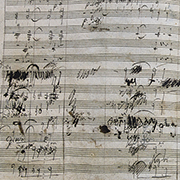Barry Cooper offers alternative variant readings in the new Bärenreiter edition, corrects uncertainties and adds a rediscovered composition with a close connection to the Mass.
In 1819 Beethoven agreed to compose a magnificent setting of the mass, for the enthronement ceremony of his patron and pupil Archduke Rudolph as Archbishop of Olmütz (Olomouc). The ceremony took place on 9 March 1820, but unfortunately Beethoven’s work was not ready in time. Nevertheless he continued composing it and finally handed over a score to the archduke in March 1823. He later described it as his ‘greatest work’ (‘mein gröstes werk’), and sold manuscript copies to several subscribers before publication. One copy, sent to Prince Galitzin, was used for the first complete performance of the work, in St. Petersburg in April 1824, and the following month Beethoven himself performed three of the movements in Vienna, though he never performed the entire work. It is rarely heard in its liturgical context, however, and its formidable demands remain a challenge for choral societies even today.
Several modern editions of the work have been published, most notably the one by Norbert Gertsch for the new complete Beethoven edition (Beethoven Werke Gesamtausgabe, VIII, 3, Munich, 2000). This describes each of the sources in minute detail and lists nearly all the significant variants. The new Bärenreiter edition, however, differs from this and other editions in several ways, of which the most important are as follows:
1. There are many places where an alternative reading is not merely possible but seems more plausible, and I have included many fresh interpretations of Beethoven’s intentions in the new edition. Particularly significant is the use of chorus, instead of soloists, throughout the Sanctus – not just from ‘Pleni sunt coeli’ as is usually heard in performance. Also notable is the inclusion of the soloists as well as chorus during much of the Credo.
2. Several minor inaccuracies found in other editions have been corrected, such as the second note for sopranos in bar 503 of the Gloria, which should be E, not F. A list of the main such corrections is provided in the Commentary.
3. Extensive advice has been given about performance issues, especially where these relate to notational ambiguities; it ranges from explanation of ornament signs to the size of forces that Beethoven preferred. Metronome marks have also been suggested, which are based on those he gave for movements elsewhere that show close similarity. The other editions provide almost no guidance about the speeds Beethoven intended, beyond his own vague tempo marks.
4. An appendix includes Beethoven’s setting of the Gregorian hymn Tantum ergo, which he made while working on the Missa solemnis and may have intended for the enthronement ceremony. The setting has only recently been identified as such, and the two works have never previously been published together.
The edition contains all the scholarly apparatus of an urtext edition, including for the first time a stemma showing the complex relationships between all the sources. But it is also aimed at those who seek a combination of a reliable text and sound editorial advice on how that text might best be interpreted in performance.
Barry Cooper
(from [t]akte 2/2018)



